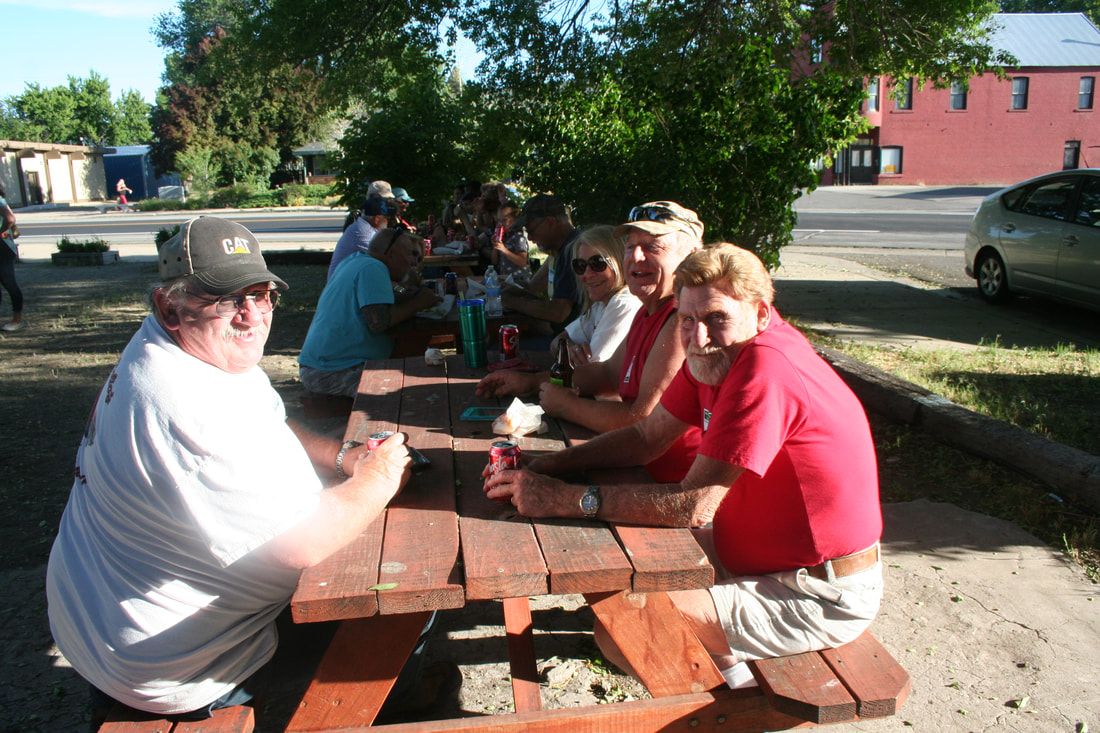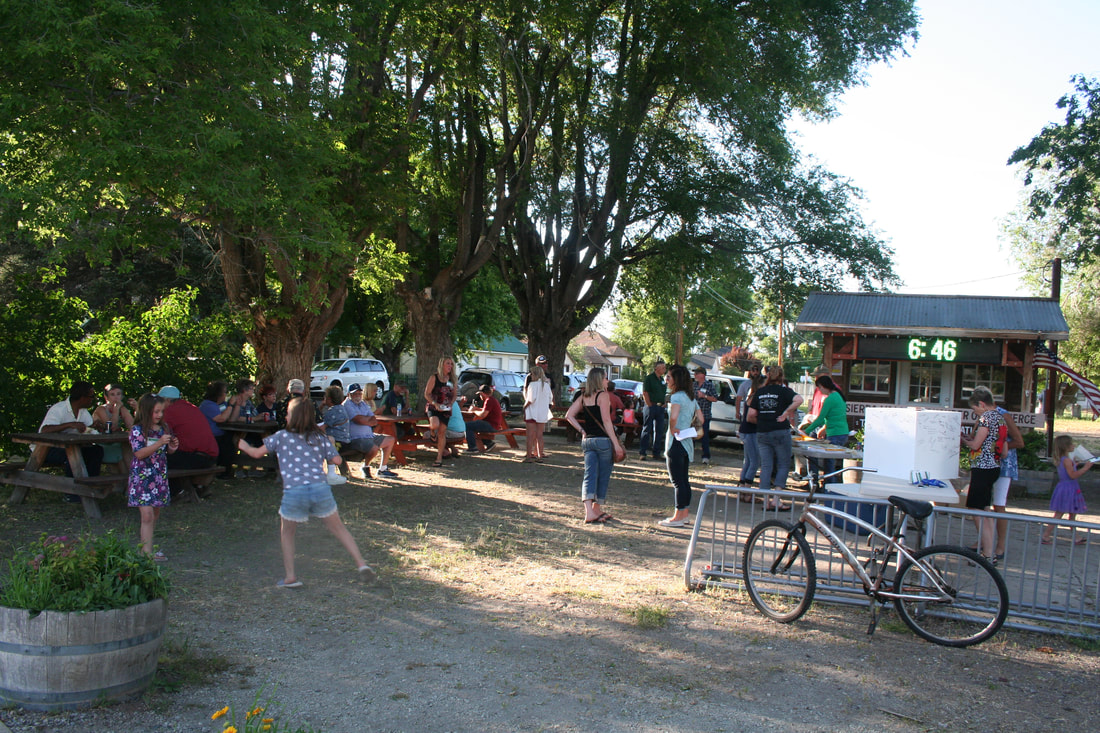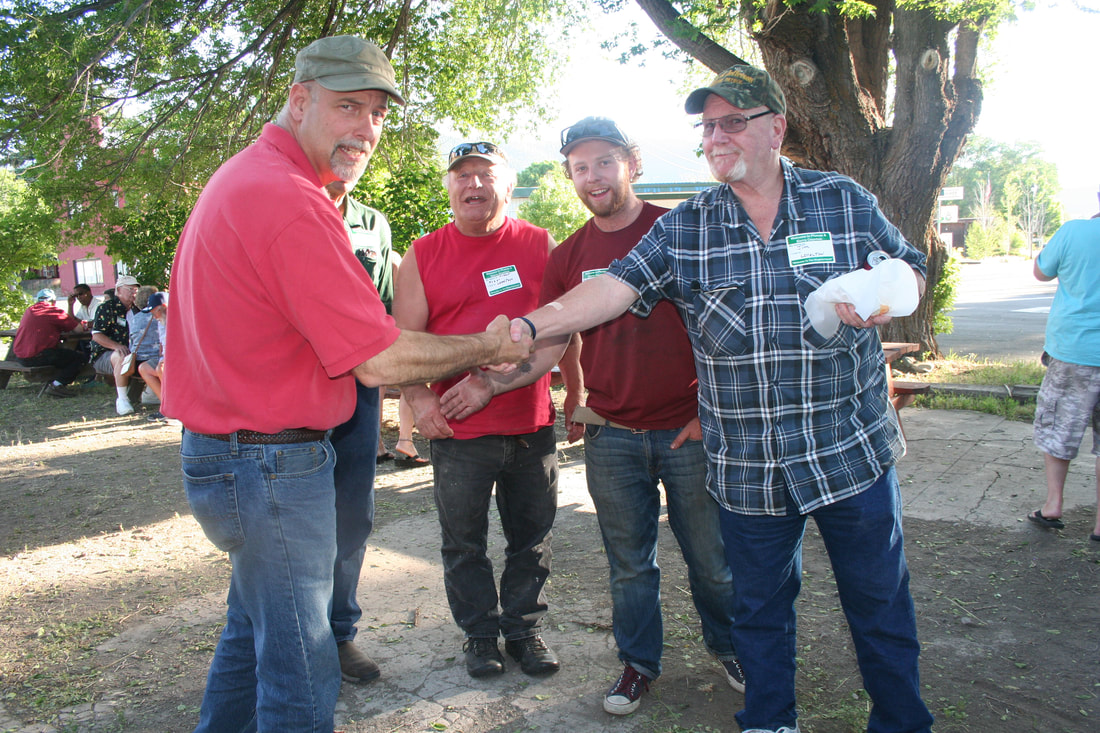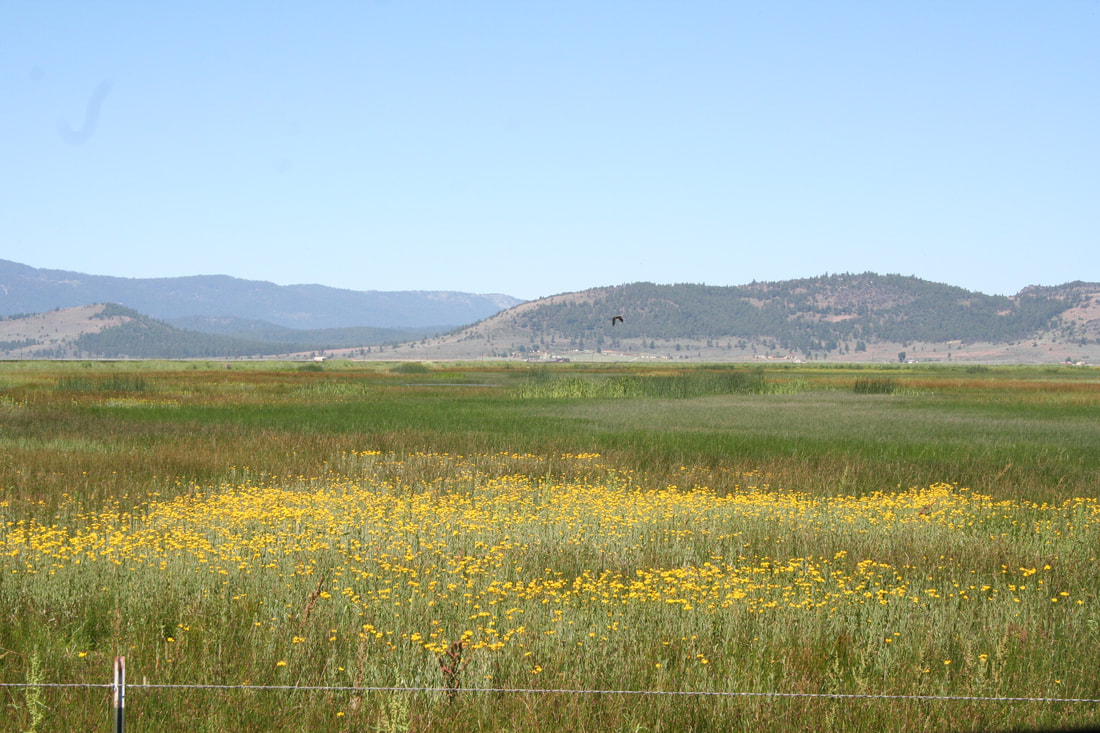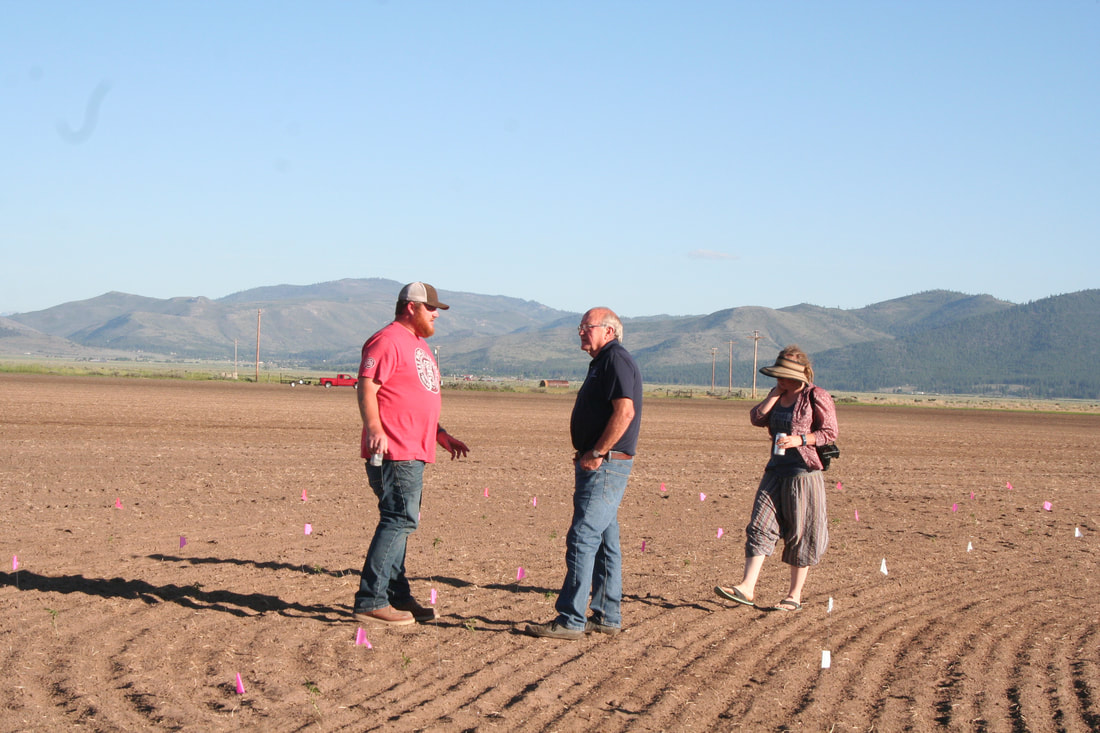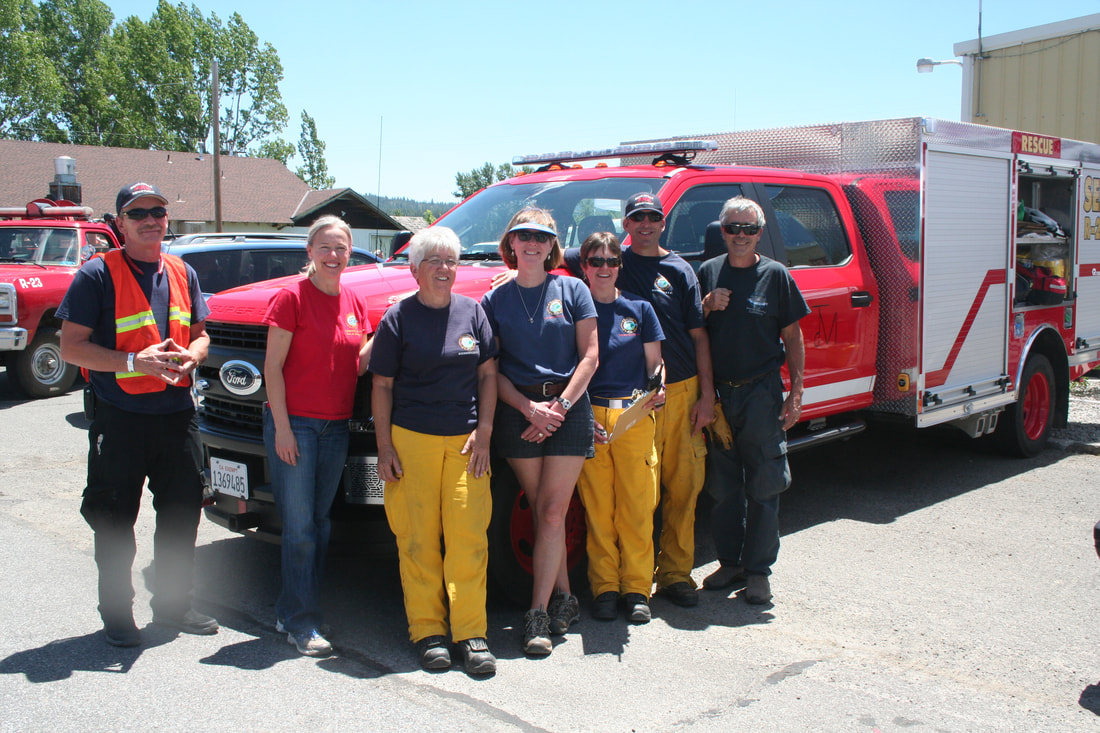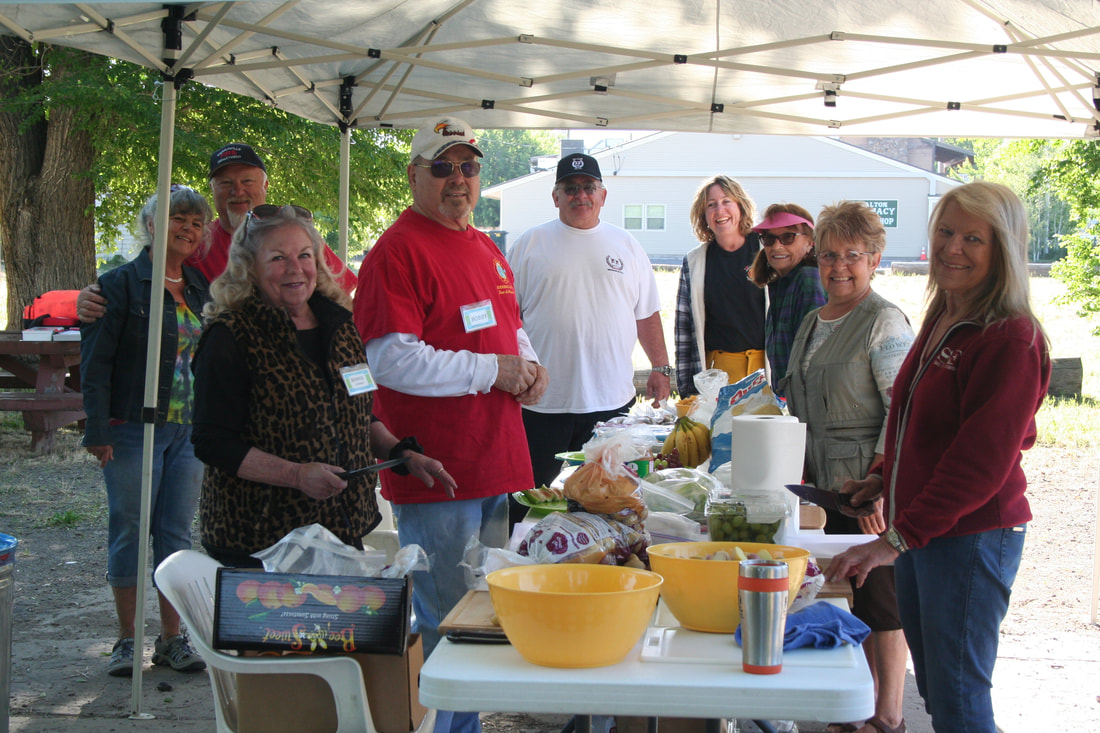The fun family event on June 28th was planned by Amber, Mike and Chelsea and included music, face painting, appetizers, and activities for the kids!
|
AT THE FUN EVENT: Dana McAdams with Avon left, Amber Donnelly with Century 21, Tracy Marr with Trinity Esthetics, Mike Summerfield with Summit Funding, Diane Bruns with Nature’s Brush, Chelsea Johnson, host of the Gilded Drifter and Michelle Milazzo Massage Dream.
The fun family event on June 28th was planned by Amber, Mike and Chelsea and included music, face painting, appetizers, and activities for the kids!
0 Comments
A FIREWISE EVENT for the Chilcoot and Vinton communities drew a sparse crowd on Saturday, June 23rd at Sierra Valley Grange Hall. The slide show presentation was given by Sue McCourt, Fire Prevention Specialist, Plumas County Office of Emergency Services with input by Sean Bassou, Battalion Chief for Plumas National Forest and the use of spectacular fire photos from last year’s Chilcoot fire by Laural Colberg. Sierra Valley Fire Chief Vicki Anderson was also present along with Gary Parque, chipping coordinator for Plumas County Fire Safe. The fire prevention message was particularly poignant to LouLou Litze of Chilcoot, who had lost everything in the Moonlight Fire and stated it was nice to be insured and to have pictures. The benefits of a Firewise community were explained, including how it just takes a few people to start it and is about fire awareness with no governmental oversight. Sue felt it makes sense for Chilcoot and Vinton which could include community-based projects, such as community cleanups and barbecues and demonstrations on fire extinguishers. A Firewise assessment would include the Fire Safe Council and formation of a board to do a risk assessment and preparation of a mitigation plan. along with a yearly educational event. There’s a certification application and a documentation of hours put in for fuel reduction, all at no cost. There are several Firewise communities in Plumas County with more in the process. Under question, it was stated the need for defensible space, the importance of Caltrans’ mowing, that there is not much code enforcement and the need and importance of neighbor talking to neighbor. The 30-feet distance for stacked wood from homes was discussed and how Cal Fire will do inspections and protect privacy. The event was hosted by Sierra Valley Grange and Sierra Valley Fire District. TWO 8-cubic yard trailers will be ready to be dispatched soon to any resident’s home or to a neighborhood seeking to clean up brush and other fire-risk biomass around their homes arrived this past week. It is believed this will contribute significantly to further divert material from the county landfill sites.
Grinding to process the material will be provided at the Loyalton co-gen plant. Watch for these trailers to be featured in this year’s 4th of July parade in Loyalton. LOYALTON CITY COUNCIL held a special session June 27th with Mary Fleming of Rural Community Assistance Corporation who gave details of her final water rate study with expenses, various reserves, fixed and variable costs. The water fund is $154,000 short annually of covering all costs.
She told of starting to read meters on every property and the first month requiring a full time employee, then three days a week at $4,500 and payroll taxes. She gave four options, compared to the current $32.44/month for 409 total connections or billing units. First option was 135% increase for water totaling $76.23/month. “The cost of service gives pause,” Mary stated and talked of services being hit hard. The school now pays $465/month which would increase to $1,092/month and the hospital now pays $685 which would increase to $1,610/mo. Option 2 would be equivalent dwelling units based on 20-gallon minimum flow and mostly 3/4” meters, for $58.13/month. The school would pay $1,744 and hospital, $2,325/mo. Option 3 would be $59/month with the school cost $850/mo. and the hospital, $1,254/mo. A fourth option was based on equivalent dwelling units for $48/month, called the “most liveable rate” at a $16 month rate increase yet would cost the school $1,440 and the hospital, $1,920/month and Mary suggested the Council look at how it would deal with the medical center and the school. The Council needs to follow Prop. 218, and decide which scenario, send written notices, advertise and post a public hearing and provide opportunities for dispute. The purchase of fund accounting software was discussed with Mary calling it “not cheap.” She told of Tahoe Truckee Community Foundation’s director having a “soft spot” for Loyalton and very generously do- nating $5,000 toward such software. Mary recommended Denali Fund Ascent which will satisfy the City’s needs. Joy made a motion of intent and to accept the funding, pending review by auditor Larry Bain. It was approved unanimously. It was approved to notice the County Clerk of elective offices to be filled and the transmittal of maps and boundaries for the City of Loyalton and to request consolidation of the election for the City. City elective offices for the November election are Mayor Marin’s 4-year term, one vacancy of a 2-year term and one of a 4-year term and Council member Joy Markum’s 2-year term. The 2-year City Clerk position is also up for election. No election will be held if there is an insufficient number of nominees. The council would decide to appoint or proceed with the election. CHP REPORTS:
On June 14, 2018 at 3:35 p.m., Timothy Bruton of Lake Forest, CA was driving his 2012 Toyota Camry eastbound on SR-70 just east of the SR-89 (Blairsden) Junction. Bruton had activated his left turn signal and slowed in preparation to make a left turn into a driveway. Clayton Benedict, 63, of Quincy was driving a Plumas County Public Works Dodge pickup truck east bound SR-70 to the rear of the Toyota Camry. Benedict began slowing due to the Camry slowing in front of him. Michael Knabe, 44 of Portola was driving a 2008 Hyundai Santa Fe eastbound SR-70 to the rear of the Dodge pickup truck at an unsafe speed. Knabe did not slow appropriately for traffic that was slowing in front of him and the Hyundai struck the rear of the Dodge which subsequently struck the rear of the Toyota. Knabe sustained major injuries in this collision as a result of his not wearing his seatbelt. Knabe was transported to Renown Medical Center. All other occupants in this collision were wearing their seatbelts and did not sustain any injuries. On June 14th at 6:08 p.m., Lorene Wilk, 56 of Burlingame, CA was driving a 2012 Chevrolet Tahoe northbound on SR-89 south of Sierraville at an unknown speed. Patrick Pellerin, 51 of Taylorsville was driving a 2009 Kenworth tractor with a 33-foot dump trailer southbound on SR-89 and north of Wilk at approx. 45 mph. For unknown reasons, Wilk permitted her vehicle to cross the solid, double yellow center line. Pellerin attempted to steer the tractor-trailer as far right as he could to avoid a head-on collision, but the left fender of the Tahoe struck the left drive wheels of the Kenworth tractor and the left trailer tires of the double axle trailer. The impact to the rear axles caused the Kenworth to rotate counter-clockwise and directed the tractor-trailer into the northbound lane. Wilk brought the Tahoe to a stop in the north-bound lane south of the collision scene. Pellerin was able to move the Kenworth and trailer to the west shoulder. On June 19th Issac Martinetti, 33 of Portola at approx. 10:15 p.m. stated he was driving his 2005 Toyota westbound on A-15 at approx. 45 mph. Martinetti made an unsafe turning movement to the right and the Toyota left the south road edge and collided with a dirt embankment. The Toyota rolled over and landed on its wheels. On June 24th at 9:24 p.m., Grant Fairchild, 25, of Reno, NV was driving northbound on US-395 approximately one mile south of Red Rock Road at 65 mph. Fairchild did not observe the illuminated emergency lights of a CHP patrol vehicle stopped on the side of the road to warn approaching motorists of several loose cattle in the roadway. A loose bull, black in color, ran into the path of the Toyota. Fairchild swerved and braked aggressively, attempting to avoid a collision but he was unable to avoid the bull. As a result of the collision, the Toyota sustained moderate damage to the left side of the vehicle. The bull fled on foot from the scene. On June 24th, at 10:25 p.m., Ciara O’Driscoll, 25 of Reno, NV was driving southbound on US-395 approx. three miles south of Red Rock Road at 65 mph. A loose, black cow ran into the path of O’Driscoll’s vehicle. O’Driscoll swerved to the right and braked aggressively, attempting to avoid a collision but she was unable to avoid the cow. As a result of the collision, the Hyundai sustained minor damage to the left side of the vehicle. The cow fled on foot from the scene. On June 26th at 5:45 p.m.Judith Martin, 69, of Graeagle was driving her Subaru eastbound on SR-70 just west of Grizzly Rd. at a stated speed of 65-70 mph. She observed a deer run from the south side of the highway directly into the path of her vehicle. Martin applied the brakes in an effort to avoid colliding with the deer. The deer collided with the right front and right side of her Subaru. Martin stopped, called 911 and reported the collision. By Quint Studer, author of Building a Vibrant Community: How Citizen-Powered Change Is Reshaping America As I go about my work of helping communities revitalize and reinvent themselves, I often get to see the best of America and I'm reminded that the foundations that built this country are still just as important today. It's long been said that America is all about rugged individualism, and that is true to some extent. Yes, being as self-sufficient as you can be is an admirable trait, but it only takes one so far. People need people in order to really live and nowhere is that more true than in communities. Back when our ancestors landed on our shores, they didn't head off into the woods to build a log cabin singlehandedly. No, they banded together in small communities. They worked together, struggled together, cried together, and celebrated together. They shared what they had when they could—and expected others to do the same for them when they needed help. Early Americans had to live this way. Otherwise, they would never have survived in this unfamiliar, unforgiving land. Today, something very similar is happening. We're in the middle of a massive community revitalization movement. Across America, cities and towns of all sizes are looking to reinvent themselves after a long, hard recession and several chaotic decades that turned their world upside town. For many communities, globalization and technology reshuffled the deck. Much like our forefathers and foremothers, people found themselves lost in uncharted territory. Jobs disappeared. Unemployment skyrocketed. Infrastructure crumbled. Once-bustling downtowns deteriorated. Young people moved away in search of better lives (and who can blame them). Now, we've collectively decided to look homeward. We've decided to bring our communities back from the brink. And we're not doing it as a nation of rugged individuals. We're doing it in small, tight-knit groups as we embrace the spirit of cooperation, collaboration, and partnership. Community leaders, business owners, and citizens are deeply engaged and working together to breathe new life into our downtowns. We're encouraging entrepreneurs to start new ventures. We're choosing to eat, drink, play, and shop locally. We're showing up at street festivals, volunteering, and supporting the institutions that feed, educate, and heal our community. As I look to communities that are thriving, one thing is for certain. We are still the land of opportunity. People are finding they can still start a business, make a living, and provide jobs to others. While a strong local government is part of every vibrant community, in most cases private industry is the backbone. Thriving local business communities lead to long-term prosperity. So here's what I believe: Real independence is about working hard, playing hard, building strong relationships with family and friends, and being happy in the place we've put down our roots. It's about choosing the kind of life we want to live. For the most part, this can exist only in the context of community. This Independence Day, I hope you'll take a moment to be grateful for your community and reflect on what you might do to make it better. Get involved. Find a cause that speaks to you. Share your ideas. Join together with like-minded neighbors and work to make something happen. The spirit of community is the spirit that built America. And it's what will rebuild us as we work together to create our future. # # # About the Author: Quint Studer is author of Building a Vibrant Community and founder of Pensacola's Studer Community Institute, a nonprofit organization focused on improving the community's quality of life and moving Escambia and Santa Rosa counties forward. He is a businessman, a visionary, an entrepreneur, and a mentor to many. He currently serves as the Entrepreneur-in-Residence at the University of West Florida. For more information, visit www.vibrantcommunityblueprint.com and www.studeri.org. The California Highway Patrol (CHP), Truckee Area, in conjunction with the Town of Truckee Police Department will conduct a sobriety checkpoint on Saturday, June 30, 2018, in Nevada County. Officers will be contacting drivers passing through the checkpoint for signs of alcohol and/or drug impairment. Officers will strive to delay motorists only momentarily. The goal of Law Enforcement is to ensure the safe passage of each and every motorist. A sobriety checkpoint is a proven effective tool for achieving this goal and is designed to augment existing patrol operations. “By publicizing our efforts we believe that we can deter motorists from driving under the influence and hopefully persuade them to make the safest decision during a night out, whether that be taking a taxi or designating a sober driver,” said Lieutenant Matthew Tweed, Area Commander of CHP Truckee. Lieutenant Tweed emphasized, “Traffic volume permitting, all vehicles will be checked for drivers who are under the influence of alcohol and/or drugs. Our objective is to send a clear message to those individuals that mixing alcohol and/or drugs while driving will not be tolerated. The CHP seeks to enhance highway safety by apprehending the impaired driver.” Funding for this checkpoint is provided to the CHP by a grant from the California Office of Traffic Safety, through the National Highway Traffic Safety Administration, reminding everyone to continue to work together to bring an end to these tragedies. If you see a drunk driver, call 9-1-1. Word Count: 556
Over the last year and half, Democrats in the California Legislature introduced 33 proposals to raise taxes and fees on hard working Californians. Altogether, these bills would have cost Californians more than $269 billion a year. That would have doubled what taxpayers already pay. Capitol Democrats regularly ram costly and ineffective laws and regulations through the Legislature. These bad bills have forced many family owned businesses to leave the state or close their doors for good. With these poor policies in place, it’s no surprise that California’s tax climate ranked 48th in the nation in a 2018 report by the Tax Foundation. The state also came in dead last in the nation for individual income taxes, according to the same report. While the majority party in the Legislature continues to ignore the needs of small businesses and ordinary Californians, my Republican colleagues and I will not. We have fought against harmful bills and I want to share with you a few bad for business proposals that we have successfully killed this year. For starters, Capitol Democrats attempted to ban the sale of gas-powered engine vehicles in the state. All new cars registered in the state would have had to qualify as a zero emission vehicles. Business owners, farmers and families across California would have needed to overhaul their entire transportation means at a cost that many would not have been able to afford. Thankfully, this attack on drivers fell short and Californians don’t have to worry about the restriction. Another proposal would have punished employers with large fines for making a minor payroll error. California already has strong laws on the books against wage theft. This bill would have created drastic penalties for even minor, unintentional payroll errors. Thanks to strong opposition, the bill failed to make it through the Assembly Business and Finance Committee. Sacramento needs to encourage a culture that helps businesses succeed, rather than burdening them with costly penalties every step of the way. Last on this list, but certainly not least, is a proposal that would have taken away a business’s ability to provide a safe, drug-free workplace for its employees. Democrat lawmakers pushed a bill to require businesses to provide a safe space for workers to use medical marijuana on the job. This proposal could have created hazardous and unsafe conditions with workers under the influence of marijuana allowed near heavy machinery. Although it didn’t make it through the Legislature, the proposal may be heard at a later date. We will continue fighting to ensure Californians feel safe and secure at the workplace. These are just a few of the bills introduced this year that would have hurt our state’s economic backbone. California is already one of the hardest states to do business. The list of companies abandoning the Golden State continues to grow. Even large corporations like Carl’s Jr., Toyota, Nissan and Jamba Juice have fled for better business climates. If these giants struggled in our state, imagine the pains small businesses are suffering. We need to continue to battle against the anti-business culture in the Capitol. Sacramento must start treating entrepreneurs and employers as friends and work together to help them succeed. My Republican colleagues and I are fighting to make sure they get the treatment and respect they need to thrive in our state. California and our businesses deserve better. Assembly Republican Leader Brian Dahle serves the 1st district in the California Legislature, which includes all or parts of Butte, Lassen, Modoc, Nevada, Placer, Plumas, Shasta, Sierra and Siskiyou counties. TO: High-Capacity Well Owners
FROM: Sierra Valley Groundwater Management District SUBJECT: Reporting of High-Capacity Inactive Wells The California Department of Water Resources has directed all groundwater districts to develop a sustainability plan over the next few years that addresses groundwater levels, groundwater quality, surface water interaction and more. In an effort to meet the mandates of the Sustainable Groundwater Management Act (SGMA), the Sierra Valley Groundwater Management District (SVGMD) Board of Directors has been working on ordinances and policies that will satisfy the requirements of the law. The SVGMD is responsible for measuring actual and potential groundwater extraction by municipal and agricultural high-capacity wells. In pursuit of that goal, the Board has identified a need to create a report describing the number of high-capacity inactive wells and the location of those wells to assist in the calculation of groundwater extraction capabilities in the Sierra Valley Groundwater Basin. The Board of Directors has adopted an ordinance requiring registration of all high-capacity inactive wells. The District will plot the GPS location and record your estimate of its pumping capacity. A high-capacity inactive well is defined in Ordinance 18-01 per section 3(a) and section 4(a) “as those capable of pumping 100 gallons per minute or more or constructed with casings larger than a seven (7) inch outside diameter (OD), and unmetered.” To view the ordinance in its entirety, please visit the District’s website at www.sierravalleygmd.org. Failure to register all high-capacity inactive wells on your property within the District may result in the loss of your ability to activate an inactive well for future use. Inactive wells must be registered with the SVGMD by July 1, 2018. Please contact the SVGMD clerk of the board if you have any questions or need a registration form. It was held June 22nd at the kiosk, offered by Plumas-Sierra County Fair Foundation, the non-profit corporation that exists to solely support the Plumas Sierra County Fairgrounds.
100 tacos were prepared by John and Denise Steffanic with help of Nancy Gamble and her cousin, Ruthie from Florida. LONG-TERM PROJECTS Interstate 80 (Placer County) from Long Ravine underpass to .2 miles east of Magra Road overcrossing: Roadwork continues for a $50.6 million project to construct 3 miles of additional truck climbing lane and other improvements to primarily eastbound I-80 east of Colfax, including widening the Cape Horn undercrossing bridge. No traffic interfering work is scheduled this week. Interstate 80 (Placer County) at the Gold Run State Rest and Recovery Areas (SRRAs): The EB and WB rest areas will be closed from May 9 to September 30 to bring water delivery and waste water treatment systems into compliance with current State requirements. Construction of the new system, similar to other SRRA locations, will eliminate costs associated with septic tank systems and improve the potable water delivery system. SHORT-TERM PROJECTS State Route 49 (Sierra County) from Yuba County line to Nevada Driver: Motorists can expect one way traffic controls from 7 a.m. to 3:30 p.m. Monday through Thursday for miscellaneous work. State Route 49 (Sierra County) from Rams Horn campground to Goodyear/Mountain House: Motorists can expect intermittent one way traffic controls and shoulder closures from 7 a.m. to 7 p.m. Wednesday for traffic signal work. State Route 65 (Placer County) from the I-80 junction to 1 mile south of Pleasant Grove Blvd.: Motorists can expect intermittent overnight alternating lane closures both NB and SB from 10 p.m. to 5 a.m. Monday night through Friday morning for roadway excavation. State Route 65 (Placer County) at the NB off-ramp to Stanford Ranch Rd., the NB off-ramp to, and SB on-ramp from, Galleria Blvd., including the Harding Blvd. overcrossing: Motorists can expect overnight full ramp closures and one way traffic controls on the overcrossing from 9 p.m. to 5 a.m. Monday night through Friday morning for roadway excavation. Interstate 80 (Placer County) from the Nevada Street overcrossing (Maple and Placer Streets) to the Highway 49 junction: Motorists can expect overnight right lane closures in both directions, including full ramp closures from 9 p.m. to 5 a.m. Monday night through Friday morning for crack seal operations. Interstate 80 (Placer County) at the Highway 65 junction: Motorists can expect overnight right lane and shoulder closures from 10 p.m. to 5 a.m. Monday night through Friday morning for roadway excavation. Interstate 80 (Placer County) at the Rocklin Road undercrossing: Motorists can expect right lane and shoulder closures on local cross street from 9 p.m. to 6 a.m. Monday night through Saturday morning for utility work. Interstate 80 – Westbound (Placer County) from Kingvale undercrossing to Big Bend: Motorists can expect intermittent right lane and shoulder closures from 7 a.m. to 4 p.m. Monday through Thursday for shoulder work. Interstate 80 – Westbound (Placer County) at the Elm Avenue overcrossing: Motorists can expect overnight full ramp closures from 9 p.m. to 5 a.m. Tuesday night through Friday morning for guardrail work. Interstate 80 – Westbound (Nevada County) from Hinton Rd. undercrossing to Boca Bridge/Hirschdale: Motorists can expect alternating lane closures from 10 a.m. to 4 p.m. Monday and Thursday for bridge work. Interstate 80 - Eastbound (Placer County) from Long Ravine brige to Secret Town (Magra and Alpine): Motorists can expect overnight left lane and median closures from 7 p.m. to 8 a.m. Monday night through Thursday morning for drainage work. Interstate 80 – Eastbound (Nevada/Placer Counties) from the Soda Springs overcrossing to JEO Kingvale undercrossing: Motorists can expect right lane and shoulder closures from 7 a.m. to 6 p.m. Monday for emergency work. State Route 89 (Nevada County) from Hobart Work Center to Sierra County line: Motorists can expect one way traffic controls from 7 a.m. to 5 p.m. Monday through Wednesday for miscellaneous work. State Route 89 (Nevada County) from Alder Creek Road to Donner Camp picnic area: Motorists can expect one way traffic controls from 7 a.m. to 5 p.m. Monday through Wednesday for guardrail repair. State Route 89 (Nevada County) from Klondike Flat Rd. to Prosser Creek: Motorists can expect one way traffic controls from 8 a.m. to 4 p.m. Wednesday for bridge work. State Route 89 (Sierra County) from Calpine Summit to Plumas County line: Motorists can expect one way traffic controls from 6 a.m. to 4 p.m. Monday and Tuesday for tree work. State Route 89 (Sierra County) from Old Truckee Rd. to Willow Street: Motorists can expect one way traffic controls from 6 a.m. to 4 p.m. Wednesday and Thursday for tree work. State Route 267 (Nevada County) from I-80 junction to Truckee River: Motorists can expect alternating lane closures from 8 a.m. to 4 p.m. Tuesday for bridge work. ### The Caltrans District Traffic Management Branch has reviewed each project and determined that individual project delays are expected to be less than the statewide policy maximum of 30 minutes, unless noted otherwise above. Lanes are numbered from the center divider (#1) to the shoulder (#2, 3, 4, etc.). EB/WB means eastbound and westbound. JEO/JWO means “just east of” and “just west of.” Unexpected schedule changes may occur. For current information on roadwork, delays, road conditions and emergency closures, call the voice-activated Caltrans Highway Information Network (CHIN) at 800-427-7623 (ROAD) or visit Caltrans “QuickMap” website at: http://quickmap.dot.ca.gov/ Liberty Utilities' customer service reps are getting calls from customers in both North Lake Tahoe and South Lake Tahoe areas this morning letting us know that the utility scammers are at it again!
They are calling our customers stating they are from Liberty Utilities and demanding cash payment today to avoid shut off over the weekend. And...these scammers are able to recite the customer's entire Liberty Utilities account number...scary! (We don't know how they are getting this information!) We have contacted the appropriate law enforcement agencies to let them know about this. Can you help us get the word out to our customers that: 1) Liberty Utilities will NEVER call customers demanding payment prior to shutoff. Customers receive several letters if they are in arrears asking that they contact our office to make special payment arrangements. 2) Customers should always call us directly at 1-800-782-2506 if they have questions regarding their bills. The 10 a.m. special meeting called on Friday, June 22nd was cancelled due to lack of a quorum. On the agenda was discussion over consolidation with the county for a November election.
Mayor Mark Marin's term will be up, along with Councilwoman Joy Markum's plus the two vacant seats along with the City Clerk position not filled since Tracy Smith did not reapply and now serves as Bookkeeper. Also to be discussed is approval to use wastewater treatment plant (WWTP) settlement funds to pay WWTP vendors pending USDA reimbursement. The meeting has been rescheduled to be held on Wednesday, June 27th at 6 p.m. QUINCY, Calif.—As part of its ongoing response to California’s tree mortality crisis, Pacific Gas and Electric Company (PG&E) will conduct aerial patrols in central Plumas County on June 28 and 29 to identify dead trees that could pose a wildfire or other public safety risk. “Five years of drought and bark beetle infestation in California have caused millions of trees to die or become structurally compromised. We’ve made significant progress to help reduce wildfire risk by removing dead and dying trees and we’re not slowing down. We will continue this critical safety work in 2018, Carl Schoenhofer, senior manager of PG&E’s North Valley Division. Every year, PG&E inspects and monitors every overhead electric transmission and distribution line, either on foot or by air, with some locations patrolled multiple times. Since the tree mortality crisis began, the energy company has increased foot and aerial patrols in high fire-risk areas to twice a year and up to four times a year in some locations. In 2018, PG&E expects to patrol over half of its overhead distribution lines at least two times. PG&E is using a contract helicopter service to fly foresters over the area to inspect trees. Patrolling by air allows the company to cover many miles quickly and efficiently, and reduces impacts on the ground. Residents are advised that the helicopter will fly low – at about 200 to 300 feet above the ground – along distribution power lines, and higher in areas where livestock are present. On June 28, flights will occur over the Plumas County communities of Greenville, Crescent Mills, Moccasin, Indian Falls and Paxton. On June 29, flights will occur over the communities of Meadow Valley, Quincy, Keddie, Twain, Virginia, Paxton, Indian Falls and Greenville. Depending on clear weather conditions, flights will occur between 8 a.m. and 5 p.m. About PG&E Pacific Gas and Electric Company, a subsidiary of PG&E Corporation (NYSE:PCG), is one of the largest combined natural gas and electric energy companies in the United States. Based in San Francisco, with more than 20,000 employees, the company delivers some of the nation’s cleanest energy to nearly 16 million people in Northern and Central California. For more information, visit www.pge.com/ and www.pge.com/en/about/newsroom/index.page. Closure of eastbound lanes necessary to remove big rig from Truckee River canyon
TRUCKEE – Caltrans is alerting motorists that eastbound Interstate 80 will be closed approximately 13 miles east of Truckee near Farad from 4 a.m. to 8 a.m. tomorrow morning, June 19 in order to remove a truck and trailer from the Truckee River canyon. Towing efforts today to remove the crashed truck and trailer from the canyon were unsuccessful. A full closure of both freeway lanes is required for the removal. All eastbound Interstate 80 traffic will be stopped at Highway 267 at 4 a.m. Towing activities may take several hours. Caltrans anticipates to re-open the freeway at 8 a.m. Weather or other unexpected events may delay or prolong the work. Significant traffic delays are expected and local highways may be impacted. Motorists are encouraged to plan for delays and adjust their travel time accordingly. Visit Caltrans' “QuickMap” for current road conditions at http://quickmap.dot.ca.gov. A mobile version is also available through the iPhone App Store or in Google Play. Motorists also can use the California Highway Information Network automated phone service by calling 1-800-427-ROAD (7623). Follow Caltrans District 3 on Twitter @CaltransDist3 and Facebook to receive the latest information about current roadway conditions. Motorists are urged to be “Be Work Zone Alert” and to “Slow for the Cone Zone.” Plumas-Sierra CattleWomen are updating their “brand napkins”. If your registered brand is already on their napkins, or placemats, your brand will automatically be placed on the new napkins at no cost. If your brand isn’t on either one and you would like it to be on the updated napkins, please send a copy of your brand, exactly as it is registered with the state, and a check for $20.00, by June 30th, to: Plumas-Sierra CattleWomen, P.O. Box 1618, Portola, CA 96122. Please make your check payable to: Plumas-Sierra CattleWomen. Any questions please call: Kathy Knight, 530-832-0395. Thank you, Plumas-Sierra CattleWomen LOYALTON WATER RATES were discussed at a special Loyalton City Council meeting held Monday, June 11th.
Mary Fleming of Rural Community Assistance Corporation told of “very preliminary numbers,” and working with Assistant Clerk Kathy LeBlanc on the number of connections and to meet on a budget and the need to be as “realistic as possible.” She told of having taken three years of prior experience and getting water and sewer operator John Cussins’ input and forecasting five years out and using a 3% inflation formula. Mary told of all operating costs and explaining reserve accounts using an operating budget of $174,765 and debt service of $61,954, a USDA water loan, for a total of $236,719. Water rates now run short $150,000 annually and Mary told of trying to cut costs while increasing revenue. The rate is now $32.44/month and Mary told of a possible increase of $45-50/month for water alone. In comparing billings, she told of $25,000 a year not getting paid. If not getting collected, she told of the need to shut off water. There was discussion over the use of existing meters and Mary explained an increase has to happen for safe, reliable water. In the audience, Eileen Benson made a plea for those “broke and it would bankrupt.” Phyllis Mitchell questioned sewer rates. Mary called Loyalton “the kind of community we work with all the time.” Brooks Mitchell talked about the loss of the trailer park and 44 hook ups and how the smaller population pays a larger amount. Mary talked of a base rate increase immediately and to see if they can get more readable meters. She called Prop. 218 as “throwing a wrench on small communities.” The Council would put up a Prop. 218 hearing and would put it in effect 45 days after publication of a public notice. If it failed, they’d look at alternates not to cover as much. If the County were to take over it might be more reliable but she said rates would go “way up” to add county overhead costs. Rates will not go down, she emphasized. There was talk of Loyalton being a disadvantaged community and looking at median household income and using Prop. 1 funding. Mary stated her first priority was sustainability of the water system and to do it as easily as possible for the residents but she called rates “artificially low.” Mary introduced Karen D. McBride, Rural Development Specialist-Environmental who is State certified as a wastewater operator Grade 2. She’s worked at RCAC 21 years and talked of transferring Cussins’ knowledge into a resource binder. New to RCAC, Bridget Harris was also introduced in finance management with an MBA in finance. She came with her beautiful service dog, “Addie.” (Washington, DC) – Congressman Doug LaMalfa (R-Richvale) issued the following statement after the House passed a package of bills to help combat the rising public health crisis of opioid abuse in the United States. Throughout the week, the House will also be voting on additional bills to help fight the opioid epidemic. The Center for Disease Control and Prevention reported that nearly 64,000 opioid deaths were recorded in the United States in 2016 alone. LaMalfa said: “Addiction to opioids kills an average of 115 Americans daily. These could be family members, friends, or neighbors that suffer from opioid addiction, and it’s an epidemic that’s only getting worse. That’s why Congress is doing our part to help slow this crisis which impacts communities all across the country. The legislation we’re passing this week will help prevent illegal drugs from entering the country, change how painkillers are distributed, and make treatment for addiction easier to access, among others. These are bipartisan efforts that both the Administration and this Congress have prioritized, and we’ll continue working on legislation that can help foster real progress.” For a comprehensive list of opioid bills being voted on this week, courtesy of the office of the Majority Leader, click here. Congressman Doug LaMalfa is a lifelong farmer representing California’s First Congressional District, including Butte, Glenn, Lassen, Modoc, Nevada, Placer, Plumas, Shasta, Sierra, Siskiyou and Tehama Counties. 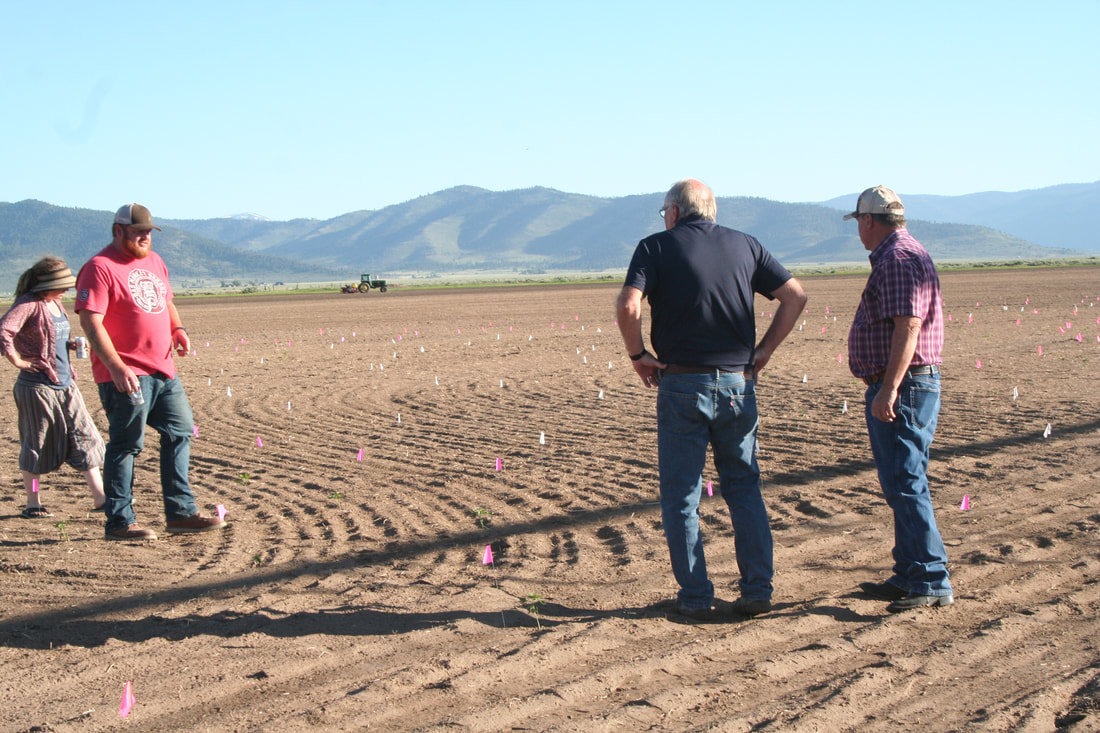 ROBERTI RANCH historically known for its cattle and hay operations in Sierra Valley, announced at a media night held at the ranch on Monday, June 11, 2018 their new farming venture with University of Nevada, Reno: A24 Farming is set to pioneer the hemp industry in the Sierra Valley. A24 Farming and Roberti Ranch are two different entities due to major insurance companies still considering hemp a drug. Local media and those involved in the project were invited to the ranch where the new product as well as Sierra Valley were showcased. Folks were bussed and toured the site, walking the areas having been planted. Speaker for the project, Dave Roberti, said they want the public to understand what hemp is, that it is a different plant than marijuana and the tetrahydrocannabinol (THC) has to be .3% or less to be considered hemp. Working with University of Nevada, Reno makes the entire project for research with a brand new crop forging new territory. Roberti introduced major players in this undertaking: Kevin Moats of Harvest Tek is A24 Farming’s contact and “main guy managing the whole thing,” by supplying the plants and seed, helping Robertis with consulting for the growing and harvesting and contracting with him when the product is sold as Harvest Tek will buy it back. Kevin plans on filling different contracts for creams, oils and isolates and they make different versions of crude oil. He found Sierra Valley ground “amazing; very neutral.” Dr. Glenn Miller, Professor, Department of Natural Resources and Environmental Science from UNR will be doing a lot of research. Miller said the whole thing is a research project and he will be looking at spacing; can you grow it on half the water; how do you control the weeds and pests. Roberti stated they can’t call up many people to see what works because it is so new. The only other farm that is mechanically harvesting hemp is in Colorado. Roberti said, the harvesting is still iffy. He stated they plan on using a corn head to cut it and thinks it will work just fine. Roberti said they will harvest some by hand and will try using a modified combine, which is what Colorado uses. Erica Kay, a Ph.D. student from UNR who studied pest management on hemp, will be advising as well. Roberti stated the project had been delayed due to weather, but they finally started planting the last couple of days. They will be planting 160 acres, which is "huge" for a hemp project. Most hemp is grown in 10-50 acres. Roberti said they will be planting some by plant and some with direct seed, to see what performs well, and what doesn’t. A24 Farming plans to have a couple hundred thousand plants growing. One of the biggest reasons they chose to do this project is the dairy market is starting to collapse which will have a big direct impact on their markets for selling alfalfa. Roberti said Sierra Valley is very limited in what they can grow and hemp can handle frost, a variety of soil conditions, likes elevation, and Sierra Valley doesn’t have insect or mildew problems like other elevations. He added, hemp uses a half to a third of the water alfalfa uses. Working with University of Nevada’s research facility for higher eduction makes A24 Farming exempt from most federal laws restricting hemp right now. There’s been discussion with Plumas County Sheriff Hagwood who is said to see no problem with how it’s grown and planted, completely legal. Taking the leap to grow hemp through A24 Farming, gives the upcoming leaders of the family such as Jay, Ben, and Weston, the chance to be involved with the decision making of planting and exploring a new crop. It also potentially provides a way for the entire family to continue making a living in agriculture. The late Elmer Roberti was one wise man and his family members are reminded of something he often said, “If you’re not going ahead, you’re falling behind.” “It’s a bunch of firefighters who never get on bicycles, putting on a century ride for people who do!” says Doug Read, founder of the one of California’s quirkiest rides, Sierra Valley’s Tour de Manure Metric Century.
Cyclists say they love the Tour de Manure most because of its spirited volunteers. At the registration booth in Sierraville, Dwight Brooks sets the tone with a few country yodels. Out in the valley, a padre of “Turn Cowboys” waves directional signs to guide you through tricky intersections; just when you think you’re riding into a meadowland outer space, a homemade lemonade stand appears, run by the Spencer family next to their ranch; bicycle clubs and church groups people the rest stops, offering the kind of food the gold miners hefted through the mountains in their sacks; at the finish line party in downtown Sierraville, firefighters don’t let the cyclists go hungry, serving up BBQ chicken and trip tip, along with pasta, salad, juicy garlic bread and homemade desserts, while Michael Hogan and his retro country rock ‘n’ roll band The Simpletones play live on a turquoise Chevy truck. The ride itself is glorious, circling one of northern California’s great secrets, the headwaters of the Feather River, stitching together the ranches that have been the region’s keepers since blue-eyed Swiss-Italian dairy farmers arrived in the valley 150 years ago. The Tour de Manure gets its name from the weeks in May when the cows come home from their winter grazing grounds in California’s Central Valley to enjoy the water-drenched grasses of the high meadows for summer. Journeying along Highway 49 (the Gold Rush Highway) and county road A-23 and California State Route 70 (a route that Irish/British/African American explorer Jim Beckwourth charted across the Sierra), in long-haul trucks, they mark their passage with polka dot sprinkles of manure on the pavement, a familiar site and smell in the delightfully fertile weeks of spring. The Tour de Manure threads wetlands full of red-winged blackbirds, yellow-headed blackbirds, and pairs of nesting Sandhill Cranes. Redtail hawks circle overhead, and an antelope or two might bound away across a field. At Sierra Hot Springs lodge, thermal springs bubble steam, while in Calpine nearby Indie-folk-country bands rattle the walls at Sierra Valley Lodge. Mostly, it’s just a real pleasure to soak in the Sierra Valley scene and enjoy the hospitality of its people. There’s only a little climbing in this tour, primarily at the end when Highway 49,bounds over three sagebrush-speckled swells. The 62-mile route starts in Sierraville heading west toward Sattley, turns north on A-23 to Beckwourth, then east for 2.5 miles on busy State Route 70 , through the valley on A-24 into Loyalton and Sierra Brooks, and down Highway 49 back to Sierraville. The 42-mile route cuts off the Sierra Brooks section. The 30-mile route follows the curves of Highway 49 from Sierraville to Loyalton and back. *Proceeds benefit Sierraville Volunteer Fire and Rescue! SACRAMENTO – Today, Assembly Republican Leader Brian Dahle (Bieber) released the following statement in response to the Legislature’s approval of the 2018-19 state budget: “The Legislature claims to have passed a balanced budget today. Unfortunately, it ignores the state’s $200 billion in unfunded pension debts and liabilities. Eventually, that bill will come due and it’s not likely to happen in a year we have a $9 billion surplus. Sooner or later, taxpayers will pay the price for our government’s irresponsible budgeting.” Assembly Republican Leader Brian Dahle serves the 1st district in the California Legislature, which includes all or parts of Butte, Lassen, Modoc, Nevada, Placer, Plumas, Shasta, Sierra and Siskiyou counties. As Father's Day (June 17) rolls around, we are mindful that it wasn’t that long ago when a father’s job was to attend his daughter’s pretend tea parties and make her a pretty dollhouse. But today’s fathers must navigate a new world and avoid gender specific roles. “The fathers of today’s girls need to be engaged, creative and flexible,” says Sheri D. Engler, author of The Pearls of Wisdom: A Fairy Tale Guide to Life’s Magic Secrets for All Ages (www.thepearlsofwisdombook.com. All proceeds go to the Angel Whispers Foundation, which was organized to empower young females.) She says today’s dads should encourage girls at every opportunity. “Women are breaking down many barriers, but there is still a lot of work to be done,” Engler says. “Today’s fathers play a critical role in their daughter's self-image and can be instrumental in encouraging them to challenge the status quo." Engler offers the following tips for fathers who want to raise their daughters to be strong, independent women: ● Treat women with respect. Your daughter is watching how you treat women, and it will have a lifelong impact on her in ways you can’t imagine. You must be cognizant of your attitude and behavior around women at all times. This includes not saying negative things about her mother if you are divorced. See yourself as a role model of the kind of man you would want your daughter to marry one day, because that frequently influences how women choose their partners. ● Give her compliments about things other than her beauty. It is OK to tell your daughter she’s pretty, but that should not be the only compliment you give her. Compliment her intelligence, her resourcefulness, her imagination, her many skills, her hard work, and her strength. Honestly tell her the unique things you love about her, the things that make her a good and special person. ● Teach her the magic of self confidence. Teach her about the power that comes from believing in herself and believing she can achieve greatness in the world, while understanding that there are many girls who simply want to be a "mommy" like their , which is the most important job in the world. In this case, they may fear failing their father's expectations of greatness. There is a critical difference between encouragement to be who they are and pressure to be who they aren't. ● Teach her about what has traditionally been “guy stuff.” Teach her self-reliance, such as routine car maintenance, or mechanics in general. Teach her how to use tools while building a treehouse. Go fishing together. Take her to see planes at air shows, teach her photography and go birdwatching with her. It matters to spend quality time with her, because it makes her feel she is worth her dad’s time. And it doesn’t have to stop in childhood. What could you be teaching your adult daughter? ● Let her get gritty like the boys. Teach her how to play sports from early on. This fosters tremendous social confidence as well as body confidence. Or just let her play in the mud and get dirty if that is what she wants to do. Girls don't always have to be clean and pretty. ● Introduce her to books with girl heroes. There are plenty of books to choose from, so when reading to her let her enjoy a variety of adventures including books with strong female leaders like The Pearls of Wisdom or other books that were written to empower girls. This will send the message that you believe in her. Or perhaps help her write a story of her own imagining herself as the hero or lead character. If nothing else this will give you a valuable view of how she sees herself so you know what’s going on with her. ● Share music with her. Play your favorite music and tell her why you like it and let her do the same. Take her to concerts. If she wants to play an instrument, help her learn how. Music, and the arts in general, can be very bonding experiences. “The most important change for today’s fathers is that they shouldn’t box girls in or out of anything just because they are a girl,” Engler says. “Fathers who respect the women in their lives have a better chance of raising daughters who feel deserving of respect themselves. Confidence, self-respect and family support will help them face any challenges that may come their way.” About Sheri D. Engler Sheri Engler is the author/illustrator of The Pearls of Wisdom: A Fairy Tale Guide to Life’s Magic Secrets for All Ages(www.ThePearlsOfWisdomBook.com). She is an experienced mentor, medium, and metaphysicist with a background in psychology, counseling and research. She received a BA in Clinical Psychology at San Francisco State University. June 12, 2018/by Edward RingAs reported in the Sacramento Bee and elsewhere, on May 31st Gov. Jerry Brown “signed a pair of bills Thursday to set permanent overall targets for indoor and outdoor water consumption.” After pressure from the Association of California Water Agencies and others, the final form of these bills, Assembly Bill 1668 by Assemblywoman Laura Friedman, D-Glendale, and Senate Bill 606 from state Sen. Bob Hertzberg, D-Los Angeles, offers water districts more flexibility in enforcing the new restrictions. But the focus of AB 1668, limiting indoor water use to 50 gallons per resident per day, is a step too far. Way too far. There’s nothing wrong with conserving water. But urban water consumption in California is already low, and squeezing even more out of Californians will be costly and bothersome without making much difference in the big picture. Here is a table showing California’s overall water consumption by user: Total Water Supply and Usage in California As can be seen, in a state where total human water diversions total around 65 million acre feet (MAF) per year [1], in 2010 residential customers only consumed 3.7 MAF [2, 3]. According to more recent data obtained by the Sacramento Bee from California’s State Water Resources Control Board, by 2017 the average California resident consumed 90 gallons per day, which equates to around 4.0 MAF per year. Slightly more than half of that is for indoor water, which means that on average, Californians are already consuming less than 50 gallons per day per resident! So why the new law? We must immediately rule out the desire to save significant amounts of water. On average, Californians are already in compliance with the new restrictions on indoor water consumption, meaning only a minority of households, those over the new cap, will be forced to reduce consumption. And while AB 1668 also mandates individual “water budgets” for outdoor water consumption, even if they cut all outdoor water use by another 20%, that would only save 400,000 acre feet. But at what cost? THE COST TO FURTHER REDUCE INDOOR WATER CONSUMPTION Here is a fairly recent analysis of what it costs to implement comprehensive indoor water savings [4]: Cost to Retrofit a Home to Reduce Water Consumption That’s a lot of money. But why? How many households are still “overusing” water, if the average consumption is only around 50 gallons per day? For what it would cost Californians who are not taking their clothes to the laundry mat, who prefer to wash their dishes in the sink, who are not willing to stand under shower heads that cannot rinse soap out of long hair, who don’t want to purchase side loading dishwashers because it hurts their back to load and unload them, how much water will actually be saved? And how does one “overuse” indoor water? Doesn’t it flow down to the sewage treatment plant, where these plants release all that water back into the streams and aquifers, or even in some cases pump the water back uphill to be reused by residents? THE COST TO FURTHER REDUCE OUTDOOR WATER CONSUMPTION For outdoor water use, the solutions are even more draconian, and, of course, are disproportionately aimed at people who happen to live in homes with yards. People with lawns where their children play, people with trees that provide shade, people with aesthetically pleasing hedges that offer privacy, people with who love to grow flowers and vegetables – people who love living things. In the short run, these people will be visited by water agency bureaucrats, who will assign a “water budget.” How much will that cost, forcing local water agencies to reach out individually to 12.5 million residential property owners? In the long run, the costs to manage outdoor water use will get much higher. Every home will need to have two meters, one to measure indoor water use, one to measure outdoor water use. These meters, increasingly, will be “smart,” able to monitor time-of-day use in anticipation of variable pricing depending on when you water. (Don’t water your plants after 9 a.m.!) And eventually, first in new construction, and later in retrofits, every home will have two sources of water supply – one pipe to provide potable water for indoor use, and a separate pipe to provide marginally less potable reclaimed water for outdoor use. This is epic folly. These conservation measures, as described, are going to cost consumers tens of billions of dollars. When fully implemented, the total annual savings might be around 500,000 acre feet. That’s less than one percentof California’s total human water diversions for agriculture, the environment, commercial, industrial, and residential use. And not one dime of this money will be instead paying for water treatment, water storage, or desalination projects that could add millions of acre feet to California’s annual water supply. THE ALTERNATIVE TO THE MALTHUSIAN MENTALITY Thomas Mathus was an English cleric and scholar living in the early 19th century who developed the theory that global population increases exponentially, while global production increases arithmetically. His theory, and the eventual collapse of civilization that it implies, has enjoyed lasting and ongoing influence. In California, it found its earliest expression in a 1976 speech by Gov. Jerry Brown, who announced that we had entered an “era of limits.” For over forty years now, Governor Brown, and like-minded environmentalists and the politicians they’ve influenced, have embraced the Malthusian vision. But there is an alternative. One of the most thoughtful and bipartisan visions to counter the Malthusian mentality is offered by the so-called EcoModernists, who in April 2015 published the “EcoModernist Manifesto.” The powerful premise they offer to confront the Malthusians is this: “Both human prosperity and an ecologically vibrant planet are not only possible, but inseparable. By committing to the real processes, already underway, that have begun to decouple human well-being from environmental destruction, we believe that such a future might be achieved. As such, we embrace an optimistic view toward human capacities and the future.” The devil is in the details, of course. What “real processes” are they referring to? One of the authors, Michael Shellenberger – who just ran as a Democratic gubernatorial candidate in this week’s primary – offers concrete examples. Shellenberger, who runs the nonprofit “Environmental Progress” in Berkeley, is a progressive Democrat. And yet he strongly advocates nuclear power, desalination plants, and permitting suburban housing developments on California’s vast tracts of cattle rangeland. There is a convergence possible here, of pro-growth progressive Democrats joining independent voters and Republicans to embrace ecomodernism instead of malthusianism. In practical terms, this would mean rejecting rationing of water, energy, land and transportation, and instead investing in infrastructure for the 21st century. In ideological terms, it would mean rejecting environmentalist extremism rooted in pessimism in favor of economic growth rooted in optimism. THE HIDDEN AGENDA OF CALIFORNIA’S MALTHUSIANS California’s voters have not questioned Malthusian policies, partly because they’ve been oversold the environmentalist agenda, and partly because too many of them have been convinced that nothing matters more than the color of their skin or the consequences of their gender. As a result, leftist oligarchs have been left free to consolidate their interests. Water rationing is just one manifestation of policy-driven artificial scarcity. This Malthusian policy also informs suppression of energy development, land development, and sensible investment in road and freeway upgrades. Public money is diverted to preposterous projects such as high-speed rail, while private investment in energy and housing is proscribed to exclude all but the wealthiest players. And those politically connected billionaires then make outrageous profits when their products – energy, utilities, housing – are produced at constant costs but sold at scarcity driven sky-high prices. The reason Malthusian ideology constitutes the conventional political wisdom in California has little to do with the environment. It has to do with power and profit. These spectacularly wealthy special interest billionaires have coopted politicians, mostly Democrats, to spew the rhetoric of environmentalism and identity politics because it makes them richer, at the same time as it has made everyone else poorer. Everyone knows that California has the highest cost-of-living in the United States. But less understood is where all that money is going. It is going into the pockets of left-wing billionaires. To ensure government complicity, government unions get their cut, in the form of staggeringly over-market rates of pay and benefits. POLICIES SHOULD NURTURE ABUNDANCE, NOT ENFORCE RATIONING Permanent water rationing sets a horrific precedent. It also is just the wrong way to solve water scarcity. Let farmers sell their water to cities without losing their grandfathered water rights. For that matter, reform the water rights that allow farmers to buy water for next to nothing. Invest in more surface and ground storage to harvest storm runoff. Build desalination plants on the coast of Los Angeles County – BIG ones like they use in the Middle East, producing millions of acre feet per year – using less energy than the Tehachapi pumps. Water is life. People should be able to use as much water as they are willing to pay for, and if they are required to pay a slight premium for overuse, that can fund investment in more water infrastructure. But the law as written will impose punitive fines for overuse. For less money than the cost of implementing water rationing, Californians could experience water abundance. From fragrant lawns to a rejuvenated Salton Sea, to not having to choose between taking a shower or doing the laundry, Californians can enjoy a better quality of life. We don’t have to live in a society defined by Malthusian struggle. We can create abundance of water and energy in ways that are largely if not completely decoupled from environmental harm. Conservation has its place but when it is the only solution and is not accompanied by increasing supply it reveals its hidden agenda: Greed for money on the part of the firms that manufacture the instruments of conservation, greed for power on the part of the politicians that enforce conservation, and a contempt for the aspirations of ordinary people on the part of environmentalists who have let their principles run amok. Nobody should have to submit to monitoring of how they use water and submit to punitive fines if they use more than their ration. The idea that everyone has to submit to draconian restrictions on their water use is ridiculous. It comes from a Malthusian mentality that is admirable in moderation and tyrannical in the extreme. REFERENCES Permanent Water Rationing is Coming to California, January 17, 2018 Increasing Water Supply Must Balance Conservation Measures, February 21, 2017 California’s Misguided Water Conservation Priorities, August 27, 2016 FOOTNOTES (1) Total Precipitation in California during wet, average, and dry years: California Water Supply and Demand: Technical Report Stockholm Environment Institute Table 2: Baseline Annual Values by Water Year Type and Climate-Scenario (MAF) http://sei-us.org/Publications_PDF/SEI-WesternWater-CWSD-0211.pdf 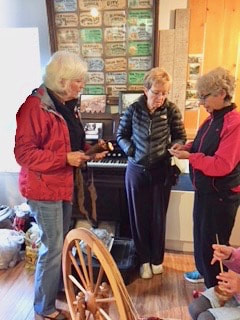 The Kentucky Mine Museum in Sierra City kicked off the 2018 season with a fun-filled event on Memorial Day weekend. Visitors enjoyed free tours of the historic stamp mill, as well as a barbeque, spinning demonstrations, mock jail, ice cream sundaes, magic show, face-painting, and a concert by the Heifer Belles. If you missed the event, don’t despair! The museum will be open 7 days a week this season from 10 am -4 pm, with guided stamp mill tours at 11 am and 2 pm. You can also attend our Music at the Mine concert series where you will be treated to live music under the stars. For more information about the museum or the concerts, go to sierracountyhistory.org Janet Baldridge demonstrated spinning. Janet Baldridge demonstrated spinning. 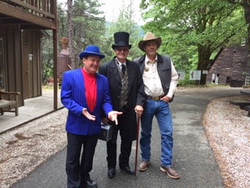 The magician, the judge, and the lawman: Bill Sparacino, Rich Nourse, and Bryan Davey. Celebrating America’s independence this Fourth of July? There’s a tax for that. Legislative Democrats have proposed a tax increase on Fourth of July fireworks sales. The new fireworks tax will tack on another 3 percent to each fireworks purchase. Even though the state is working with a $9 billion budget surplus this year, Legislative Democrats cannot seem to get their hands on enough taxpayer money. “Democrats have hit Californians with a new gas tax and housing tax over the past year,” said Assemblyman Matthew Harper (R-Huntington Beach). “Now, they want a new fireworks tax too?” The fireworks tax (SB 794) will reach deeper into consumers’ pockets and likely reduce sales for local non-profit organizations that operate most fireworks stands in the state as fundraisers. Republicans in the Assembly and Senate have united in opposition. You are receiving this email as part of an ongoing effort to deliver accurate and factual information about the activities of your local representatives in Sacramento, and how their votes either improve or negatively impact the lives of Californians. For more information, please contact the Assembly Republicans at (916) 319-2001. |









